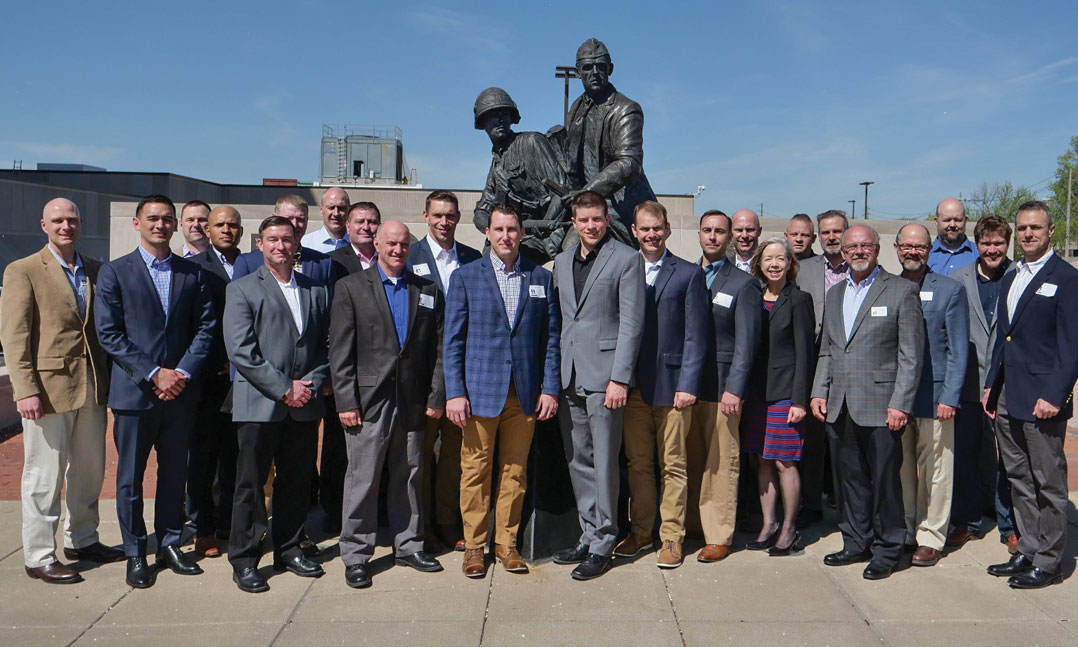VFW leadership touted its progression toward community-based events and family friendly environments to a class from Fort Leavenworth’s School of Advanced Military Studies (SAMS).
 Fort Leavenworth School of Advanced Military Studies students visit with VFW leadership in April at the Citizen Soldier statue, located at VFW National Headquarters. The students sought a discussion with VFW personnel to better understand the organization’s future-planning strategies. In April, students from the school, which is roughly 40 miles from VFW National Headquarters in Kansas City, Mo., met with VFW employees to have a conversation about how the veterans organization prepares for the future.
Fort Leavenworth School of Advanced Military Studies students visit with VFW leadership in April at the Citizen Soldier statue, located at VFW National Headquarters. The students sought a discussion with VFW personnel to better understand the organization’s future-planning strategies. In April, students from the school, which is roughly 40 miles from VFW National Headquarters in Kansas City, Mo., met with VFW employees to have a conversation about how the veterans organization prepares for the future.
The students consisted of U.S. military members, one Department of Defense civilian and a Canadian officer.
VFW Quartermaster General Debra Anderson told the students — 13 active-duty and one Department of Defense civilian — that successful Posts focus on providing opportunities for members, who don’t necessarily attend every Post meeting, to be involved.
“We have to remind our Posts that change can be good. Be open to new ways of doing things, which may mean more streamlined meetings with less ritual,” said Anderson, a member of VFW Post 7356 in Parkville, Mo.
In addition to shifting focus toward community activities at the Post level, National Headquarters staff reaches veterans of all eras through social media campaigns, participating in events that veterans attend (such as the Bataan Memorial Death March) and offering scholarship and mental-health awareness programs.
In the past, according to VFW Membership Director Rick Butler, VFW failed at letting younger veterans “know what was in it for them.”
However, he said National Headquarters staff conducts membership classes that explore the advantages and challenges of generational differences.
Conversation also veered toward eligibility and whether or not to expand it.
Maj. Jared Nichols questioned whether, hypothetically, a drone pilot based in Nevada would ever be eligible for VFW membership, because he said he sees technology and how the military uses it trending in that direction.
“It might be [that] pilots are not in airplanes, or infantrymen are using a remote controller,” Nichols said.
While there are no plans at this time to change membership requirements, Butler said that as technology shifts, the organization will have to consider such changes in military structure in the future.
When asked about the challenges VFW faces, Anderson said VFW is working to address how to:
- Stay relevant;
- Present the organization well;
- Have appealing programs;
- Grow membership; and
- Preserve its revenue base.
Additionally, the VFW works to meet the younger generation of veterans’ needs by working toward diversity at its Kansas City and Washington offices.
The best way to understand the needs of various generations and demographics is to have them represented on staff. VFW also has updated its recruiting methods, according to Butler.
“If you went back 10 years and said VFW was going to go to an event, it’d be a gun show,” Butler said. “Now we’re at NASCAR events, gaming events, Comicon events.”
During the discussion, the SAMS students suggested various ways for VFW to approach its strategic planning, including:
- Testing ideas at a few Posts to see what works on a smaller scale.
- Create a shared understanding of VFW’s vision at all levels.
- Work with other organizations.
Discussion topics also included branding, image, marketing, VFW’s various programs, corporate partnerships and changing veteran demographics.
This article is featured in the September 2019 issue of VFW magazine, and was written by Kari Williams, associate editor for VFW magazine.